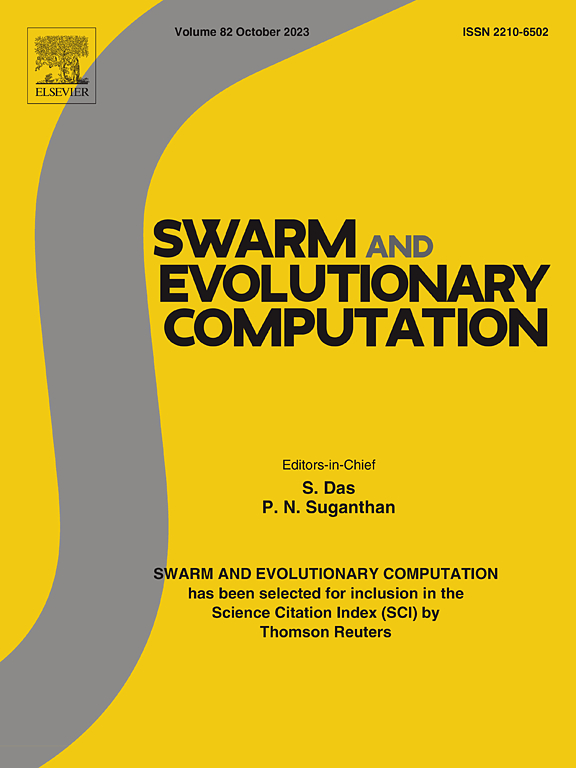OS-BiTP:基于目标排序的动态多目标优化双域信息传递预测
IF 8.5
1区 计算机科学
Q1 COMPUTER SCIENCE, ARTIFICIAL INTELLIGENCE
引用次数: 0
摘要
基于迁移学习的预测响应机制在动态多目标优化算法(DMOAs)中广泛流行,DMOAs将历史信息转化为跟踪Pareto集(PS)或前沿(PF)的新环境。然而,许多现有的方法学习从旧到新群体的整体变化信息进行预测。由于种群内个体变异的不同特征,这必然会导致在训练过程中,更多相关个体的有效信息被部分削弱,从而降低基于迁移预测的准确性。为此,本文提出了一种基于个体目标变化的基于客观排序的DMOA双域信息转移预测(OS-BiTP)方法,目的是转移具有相同特征的个体。OS-BiTP的三个核心组件是基于变量的目标排序(VOS)、目标空间内的双域信息传递(BiTOS)和决策空间内的双域信息传递(BiTDS)。具体而言,VOS将当前PF分为高目标和低目标变化类,并设计了一种改进的线性预测机制来预测新的环境目标向量。然后,VOS训练一个简单的迁移学习模型,将新旧环境个体与相同的客观变异类进行匹配,以提高个体的迁移效率。为了准确跟踪动态PFs和PSs, BiTOS和BiTDS对同一类目标向量和非主导解进行类内相关比对,并根据其变异差异对预测目标向量和解进行微调。通过与七个最先进的dmoa的系统比较,数值结果表明了OS-BiTP的优越性能和应用。本文章由计算机程序翻译,如有差异,请以英文原文为准。
OS-BiTP: Objective sorting-informed bidomain-information transfer prediction for dynamic multiobjective optimization
Prediction response mechanisms based on transfer learning are extensively prevalent in dynamic multiobjective optimization algorithms (DMOAs), which transform historical information into a new environment for tracking the Pareto set (PS) or front (PF). However, many existing methods learn information of overall changes from old to new populations for prediction. Due to the different characteristics of individual variation within the population, this inevitably causes the valid information of more relevant individuals to be partially weakened during the training process, thus reducing transfer prediction-based accuracy. Therefore, this paper proposes an objective sorting-informed bidomain-information transfer prediction (OS-BiTP) for the DMOA based on individual objective variation, with the aim of transferring individuals within the same characteristics. The three core components in OS-BiTP are variation-based objective sorting (VOS), bidomain-information transfer within objective space (BiTOS), and bidomain-information transfer within decision space (BiTDS). Specifically, VOS divides the current PF into high- and low-objective variation classes and designs a modified linear prediction mechanism to forecast new environmental objective vectors. Afterward, VOS trains an easy transfer learning model to match old and new environmental individuals with the same objective variation classes to increase the transfer efficiency of individuals. To accurately track dynamic PFs and PSs, BiTOS and BiTDS perform intraclass correlation alignment for the same class of objective vectors and nondominated solutions and fine-tune the predicted objective vectors and solutions based on their variation differences. The numerical results demonstrate the superior performance and application of OS-BiTP via a systematic comparison with seven state-of-the-art DMOAs.
求助全文
通过发布文献求助,成功后即可免费获取论文全文。
去求助
来源期刊

Swarm and Evolutionary Computation
COMPUTER SCIENCE, ARTIFICIAL INTELLIGENCEC-COMPUTER SCIENCE, THEORY & METHODS
CiteScore
16.00
自引率
12.00%
发文量
169
期刊介绍:
Swarm and Evolutionary Computation is a pioneering peer-reviewed journal focused on the latest research and advancements in nature-inspired intelligent computation using swarm and evolutionary algorithms. It covers theoretical, experimental, and practical aspects of these paradigms and their hybrids, promoting interdisciplinary research. The journal prioritizes the publication of high-quality, original articles that push the boundaries of evolutionary computation and swarm intelligence. Additionally, it welcomes survey papers on current topics and novel applications. Topics of interest include but are not limited to: Genetic Algorithms, and Genetic Programming, Evolution Strategies, and Evolutionary Programming, Differential Evolution, Artificial Immune Systems, Particle Swarms, Ant Colony, Bacterial Foraging, Artificial Bees, Fireflies Algorithm, Harmony Search, Artificial Life, Digital Organisms, Estimation of Distribution Algorithms, Stochastic Diffusion Search, Quantum Computing, Nano Computing, Membrane Computing, Human-centric Computing, Hybridization of Algorithms, Memetic Computing, Autonomic Computing, Self-organizing systems, Combinatorial, Discrete, Binary, Constrained, Multi-objective, Multi-modal, Dynamic, and Large-scale Optimization.
 求助内容:
求助内容: 应助结果提醒方式:
应助结果提醒方式:


